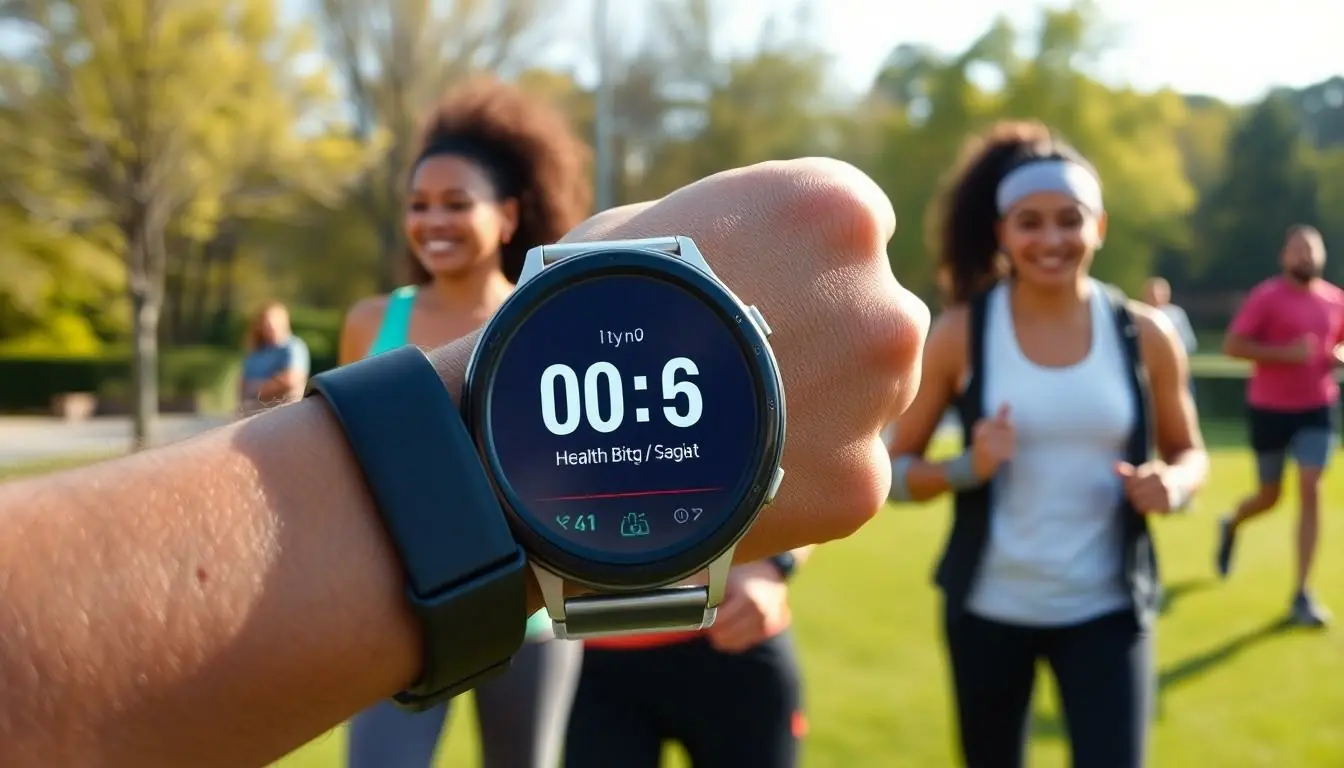Table of Contents
ToggleIn a world where technology seems to have a hand in everything, wearables in healthcare are the shiny new toys that everyone’s talking about. Imagine a wristband that not only tracks your steps but also nudges you when you’ve been sitting like a sloth for too long. It’s like having a personal trainer who never gets tired of your excuses.
These gadgets do more than just count calories; they’re revolutionizing how we approach health and wellness. From monitoring heart rates to tracking sleep patterns, wearables are turning everyday folks into health gurus. So, if you’ve ever dreamed of being your own health coach while binge-watching your favorite show, now’s your chance. Let’s dive into how these nifty devices are shaping the future of healthcare and making it easier (and a bit more fun) to stay healthy.
Overview of Wearables in Healthcare
Wearable technology in healthcare encompasses devices that monitor and track health metrics in real time. Examples include smartwatches and fitness trackers, which offer functionalities beyond simple movement monitoring. Heart rate tracking, sleep analysis, and calorie counting represent some critical features that enhance individual health awareness.
According to a study by Grand View Research, the global wearables market is anticipated to reach $149.96 billion by 2028, illustrating significant growth potential. These devices contribute to personalized health insights, enabling users to make informed decisions regarding their well-being.
Integration with mobile applications allows wearables to provide actionable data. Users can view metrics on user-friendly interfaces, facilitating immediate feedback on their health status. Improved connectivity with healthcare providers fosters real-time data sharing, which supports proactive health management.
Data security and privacy remain vital considerations. As healthcare wearables collect sensitive information, manufacturers implement robust encryption to protect user data. Compliance with regulations, such as HIPAA, ensures that individuals’ health information remains secure.
Educational resources accompanying wearables enhance user engagement. Brands frequently provide tutorials, helping users understand device functionalities and optimal usage. This approach empowers users to take control of their health through informed actions.
The impact of wearables on chronic disease management also stands out. Conditions like diabetes and hypertension benefit from continuous monitoring, leading to timely interventions. Adoption of wearables among healthcare professionals aids in tracking patient compliance, improving treatment outcomes.
Types of Wearable Devices

Wearable devices in healthcare categorize into several distinct types, each serving unique functions and addressing various health needs.
Fitness Trackers
Fitness trackers monitor physical activity, sleep patterns, and heart rate. Devices like Fitbit and Garmin provide insights on steps taken, calories burned, and hours slept. Users achieve fitness goals with real-time feedback, which fosters motivation. Integration with mobile applications allows users to track progress over time. Personalized data extends the utility of fitness trackers, enabling customized workout plans. These devices appeal to both casual athletes and those seeking to improve overall well-being.
Smartwatches
Smartwatches combine fitness tracking with advanced features, delivering notifications and health monitoring. Products like Apple Watch and Samsung Galaxy Watch offer heart rate monitoring, ECG readings, and blood oxygen measurement. Users manage daily tasks while keeping an eye on their health metrics. With apps designed for wellness management, smartwatches offer comprehensive health insights. Seamless connectivity with smartphones enhances the user experience, ensuring easy access to information. Smartwatches cater to tech-savvy individuals focusing on convenience and health awareness.
Medical Devices
Medical wearable devices occupy a specialized niche focusing on clinical monitoring. Tools like continuous glucose monitors and ECG monitors provide precise data to both users and healthcare professionals. They enable real-time monitoring of conditions such as diabetes and arrhythmias. Compliance with health regulations ensures data security and accuracy. Healthcare providers integrate information from these devices into patient care plans, improving outcomes. Medical wearables illustrate the shift towards proactive health management through continuous observation and timely interventions.
Benefits of Wearables in Healthcare
Wearable technology offers various benefits that enhance healthcare experiences and outcomes.
Improved Patient Monitoring
Continuous health monitoring becomes practical with wearables. These devices facilitate real-time tracking of vital signs like heart rate, blood pressure, and sleep patterns. Patients with chronic conditions benefit significantly, as wearables alert healthcare providers to anomalies, enabling timely interventions. Additionally, data collected supports better treatment plans, allowing for personalized care tailored to individual needs. Wearables create a proactive approach to health management. They engage patients in their health journeys, fostering communication between patients and providers.
Enhanced Data Collection
Wearables optimize data collection, creating comprehensive health profiles. Devices like smartwatches and fitness trackers gather extensive data on activity levels, sleep quality, and biometrics. This wealth of information aids healthcare providers. They gain insights into patient behavior and health trends over time, leading to informed clinical decisions. Wearables also support remote patient monitoring, improving access to healthcare services, especially for underserved populations. By consolidating data, wearables foster collaboration between patients and clinicians, enhancing overall health management experiences.
Challenges Facing Wearables in Healthcare
Wearables in healthcare face critical challenges that can impact their effectiveness and adoption. These challenges include data privacy, accuracy, and reliability.
Data Privacy Concerns
Data privacy remains a top concern as wearables collect sensitive health information. Users worry about unauthorized access to personal data, which can lead to identity theft or misuse. Regulations such as HIPAA enforce strict guidelines, yet compliance varies among manufacturers. Some devices lack robust security measures, exposing users to potential risks. Educational resources about data privacy can help users make informed choices. Understanding encryption methods and data storage practices enhances user confidence in wearable technology.
Accuracy and Reliability Issues
Accuracy and reliability play vital roles in the effectiveness of wearable devices. Many consumers rely on wearables for critical health metrics like heart rate and sleep patterns. Inaccurate readings can lead to misguided health decisions, creating distrust in the technology. Manufacturers must prioritize thorough validation and testing to ensure device performance. Independent studies often reveal discrepancies between wearable data and clinical measurements. Improved algorithms and sensor technology contribute to higher accuracy levels, making wearables more trustworthy for users. Understanding these limitations aids users in interpreting wearable data effectively.
Future Trends in Wearable Technology
Forecasts predict wearable technology will evolve significantly in healthcare. Artificial intelligence integration enhances data analysis capabilities, allowing for predictive health insights. Companies are investing in machine learning algorithms to improve accuracy and personalization in health tracking.
Telehealth capabilities will grow with wearables, enabling remote consultations with healthcare providers. Continuous connectivity between devices and health apps facilitates seamless communication for personalized care. Users will benefit from real-time data sharing, promoting proactive health management.
Health monitoring will expand beyond fitness-focused metrics. Wearables are likely to track parameters like blood pressure, glucose levels, and even mental health indicators. Advanced sensors will support the growing need for comprehensive health assessments.
Enhanced battery life will enable longer usage periods between charges, making wearables more user-friendly. Developers are prioritizing energy-efficient designs to address consumer convenience. Wearables may feature improved waterproofing and durability, catering to active lifestyles.
Data privacy solutions will continue to evolve. Users demand robust security measures with encryption techniques that comply with regulations such as HIPAA. Transparency in data handling will foster greater consumer trust in wearable technology.
Customization options for wearables will increase, allowing individuals to tailor devices according to their health needs. Personalization in design and functionality helps engage users more effectively. Market trends show a growing demand for stylish, functional wearables.
Lastly, global market expansion is anticipated, particularly in emerging regions. Access to affordable health technology will improve health outcomes in underserved populations. The projected growth of $149.96 billion by 2028 underscores the significant potential for wearables in healthcare.
Wearable technology is reshaping the landscape of healthcare by empowering individuals to take control of their health. With advancements in functionality and integration, these devices are becoming essential tools for monitoring various health metrics. The potential for growth in this market indicates a future where wearables play a crucial role in personalized health management.
As manufacturers prioritize data security and user engagement, consumers can trust that their information is protected while benefiting from actionable insights. The ongoing evolution of wearables promises to enhance chronic disease management and improve overall health outcomes. With continuous innovation on the horizon, the future of healthcare is set to be more connected and proactive than ever before.




